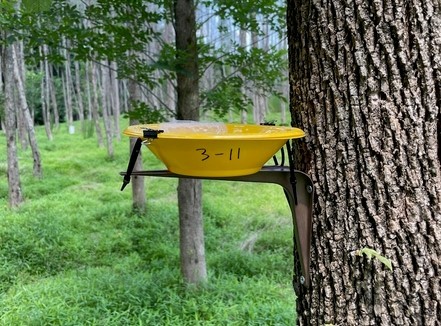USDA's Emerald Ash Borer Program Report | September 29, 2022
USDA Animal and Plant Health Inspection Service sent this bulletin at 09/29/2022 09:45 AM EDTHaving trouble viewing this email? View it as a Web page. ![]()
You are subscribed to Emerald Ash Borer Program Report for USDA Animal and Plant Health Inspection Service.

September 29, 2022
USDA’s Animal and Plant Health Inspection Service (APHIS) works with State, Federal, and other partners to detect and manage known emerald ash borer (EAB) infestations. The EAB program uses biological control and ongoing research to minimize the impact from an infestation and maintain ash as a viable part of the American landscape. This report provides the most current information on EAB program efforts.
Announcements
Action Needed in MapBioControl
Before sending your samples to APHIS’ Entomologist Juli Gould, please make sure to do the following:
- Create your recovery entries in MapBioControl. A record for each site/date should be created even if no parasitoids were recovered. The number of samples is the number of yellow pan traps or the number of sentinel logs placed in the field at that site on that date.
- Using a pencil, include the following on a piece of paper inside the vial with the parasitoids and the ethanol: a) State b) Site ID c) Recovery ID d) Date, and e) the number of suspected parasitoids.
- Remember to decant (separate) off the ethanol just prior to shipping.
If you have any questions or concerns, please contact Entomologist Juli Gould at Juli.R.Gould@usda.gov.
Last Call For Release Photos
Please email photos from the field showing your work during the release season to eab.biocontrol.program@usda.gov. Please make sure to send the original or large size of the photo. The photos should be yours and not photos that APHIS needs third-party permission to use.
Yellow pan traps are used to recover parasitoid wasps at release sites—the wasps are attracted to the yellow color and become trapped in liquid in the bowls. Photo by Ryan Bohannon, NC State University
EAB in the United States
EAB is in 36 states and the District of Columbia: Alabama, Arkansas, Colorado, Connecticut, Delaware, Georgia, Illinois, Indiana, Iowa, Kansas, Kentucky, Louisiana, Maine, Maryland, Massachusetts, Michigan, Minnesota, Missouri, Nebraska, New Hampshire, New Jersey, New York, North Carolina, Ohio, Oklahoma, Oregon, Pennsylvania, Rhode Island, South Carolina, South Dakota, Tennessee, Texas, Vermont, Virginia, West Virginia, and Wisconsin.
Biological Control
USDA uses emerald ash borer's natural enemies as biocontrol agents—these tiny stingless wasps are showing promise in terms of protecting young ash saplings in a number of states. To date, parasitoids have been recovered in 22 states: Colorado, Connecticut, Delaware, Illinois, Indiana, Iowa, Kentucky, Louisiana, Maine, Maryland, Massachusetts, Michigan, Minnesota, Missouri, New Hampshire, New Jersey, New York, Ohio, Pennsylvania, Tennessee, Virginia, Wisconsin, and in 2 Canadian provinces: Ontario and Quebec. This means the wasps are establishing, reproducing, attacking and killing EAB.
***2023 Release Season Guidelines***
Sites started in 2022—If you completed first-year releases in 2022, you will release the same at the same site(s) again in 2023 since all parasitoid species receive two consecutive years of releases.
Sites starting in 2023—Approximately 100 new sites will be accepted for first year releases of Oobius agrili, Spathius galinae (limited production), and Tetrastichus planipennisi. Top priority will be given to new states and counties. For more information about site selection, please review the Biocontrol Release Guidelines.
The deadline for site selection is December 1, 2022. Please submit detailed site information for all new release site requests to both mapbiocontrol.org online and by emailing eab.biocontrol.program@usda.gov. If you have any questions, please contact Biocontrol Rearing Facility Manager Ben Slager at 810-844-2704 or Benjamin.H.Slager@usda.gov.
Parasitoid Research
If you received parasitoids for research needs in 2022, please send 1) an update of your project needs, and 2) information on if the project has been discontinued, no later than December 1, 2022 by emailing eab.biocontrol.program@usda.gov. If you have a new first time research request for 2023, please submit your request by the same deadline and to the same email.
Data Entry Requirements
Release and recovery data must be entered into MapBiocontrol.org. Release data should be entered within 48 hours of the release. Recovery data should be entered as soon as possible but no later than 12 months after the final release in an area, and a minimum sampling of one release site per county is required. If you have any questions or concerns, please contact National Operations Manager Russ Bulluck at 919-855-7182 or Russ.Bulluck@usda.gov.
To learn more about biological control releases, please visit APHIS’ EAB Program webpage. If you have questions, please call 1-866-322-4512 or email eab.biocontrol.program@usda.gov.
Research
APHIS scientists are studying how Integrated Pest Management (IPM) might be used in a forest ecosystem to significantly reduce and control EAB populations. IPM combines a variety of tools and strategies to identify, manage, and reduce risks and impacts from pests.
Trapping
APHIS is providing traps and lures to conduct surveys. You can request traps, lures, and accessories through your State Plant Regulatory Official or you order them through the Integrated Plant Health Information System (IPHIS). Please remember to enter your survey data weekly into IPHIS.
Latest Maps
Infested Counties Map (Interactive)
Additional Resources
Informational Websites
EAB National Invasive Species Information Center
Outreach Materials
Contacts
Acting EAB National Policy Manager
Ben Slager, 810-844-2704
EAB National Operations Manager
Russ Bulluck, 919-855-7182
If you think you’ve found EAB or signs of infestation, record the area where the specimen was found and take digital pictures of the insect and tree damage. Submit your report to your State Plant Health Director, or email Report.EAB@usda.gov, or call the EAB hotline at 1-866-322-4512. Thank you.



